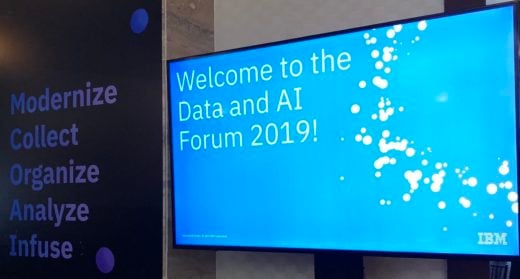My biggest takeaway from the IBM Data and AI Forum last week was how much IBM’s messaging and narratives have improved in the past year. Though this event was primarily focused around data, AI and ML, a more holistic narrative for the company overall emerged since their Think conference earlier in 2019.
To be fair, a big part of this is timing: IBM held their annual Think conference in February, when their acquisition of Red Hat had been announced by not yet finalized. As such, there was a big piece of their strategic portfolio that the company could not legally speak to. Now that the deal is closed they can tell a more full, complete story.
Noticeable at Think was the quality of the IBM story around legacy workloads with their Z and Power products, along with compelling stories of innovations coming out of IBM Research. Eight months ago, IBM delivered great stories around successes from 10 years ago and potential for products 10 years away, but that left something of a hole around how the company is relevant now, in the present.
This event greatly improved upon that narrative. IBM now has a credible cloud platform story with OpenShift in the fold, and – specific to this data/AI focused conference – a data platform designed to run on OpenShift, IBM Cloud Pak for Data. Over the course of 2019 it’s become clearer that hybrid and multi-cloud are being validated by customers, not just analysts or pundits. IBM and Red Hat’s combined platform investments help enable workload portability and helps IBM with their hybrid/multi-cloud story.
When asked about the role IBM Public Cloud plays, the answer provided was that:
- It is the initial building ground from an IBM product perspective. Everything starts with IBM Cloud, and then the hybrid/multi-cloud investments follow fast.
- IBM Cloud is an environment for developers to test and trial IBM products efficiently.
- IBM Cloud has the brand permission and technology to serve highly regulated industries.
This is a much more nuanced view about the role of their cloud assets than IBM has presented in the past.
The conference also worked to reign in the definition of the Watson brand, which had become a bit sprawling. IBM explicitly stated what Watson was not on the keynote stage – specifically that it was not a consumer product that will talk to you, like an Echo or Google Home. Trivial though this may seem, it felt like a step forward in clarity when compared to some of their earlier branding of the product – see, for example, the Serena Williams commercial here.
Watson is available to build via tools, runtimes and SDKs or to buy via pre-packaged applications. They’ve reined in the narrative around what the AI can accomplish and instead talked about how it can help augment workers and automate activities.
By reeling their messaging back in to be less assertive and more discreet, it all felt much more reasonable. Overly-ambitious marketing and positioning when demonstrably not in a position of strength can feel like a Hail Mary pass. By toning down the hype and focusing on value, IBM left the impression that they have a more attainable strategy in place and more concrete plans for a path forward.
Disclaimer: IBM is a RedMonk client and paid for my T&E to both Think and the Data and AI Summit.

No Comments